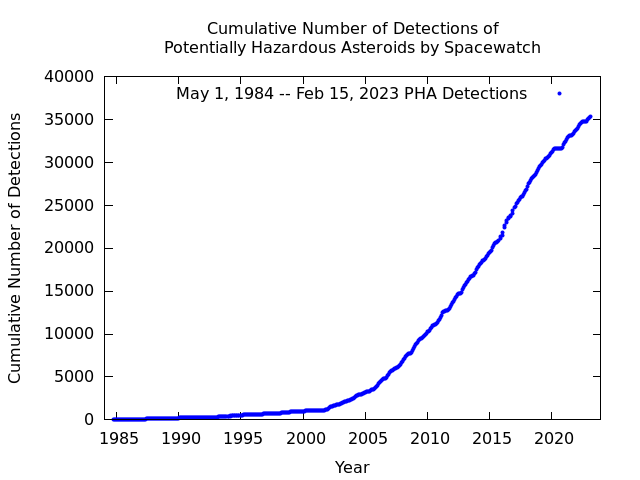Our recent results from 2024 Apr 20 - 2025 Jan 31:
- MPEC stats (PDF)
- Unique PHAs Obs By Flavor (PDF)
- Unique NEAs Obs By Flavor (PDF)
- Tally Table (PDF)
- NEA flavor table (PDF)
2023 July 24: Update on our Follow-up Astrometry of Potentially Hazardous Asteroids (PHAs) While they are Faint:
Our stock in trade has been improving knowledge of the orbits of asteroids of high priority. PHAs are minor planets with absolute magnitudes brighter or equal to 22.0, corresponding on average to diameters greater than or equal to 140 meters. That is the range of sizes on which Congress recommended that NASA concentrate. PHAs are also defined by how close their orbits approach that of the Earth. For many years we have led the international community in this category of observations. We have now checked our status in this parameter with a fresh analysis of the observations accepted by the Minor Planet Center. We looked at the time interval that began with our use of the current imaging camera at the cassegrain focus of the 2.3-meter Bok telescope, 2015 Sep 28, and ends with 2023 July 06, the latest date of the MPC's MPCAT-OBS compilation. The attached file shows that we are still the top-ranked astrometry project in the follow-up of PHAs while they are faint. Observing asteroids while they are faint can improve knowledge of their orbits more uniquely than waiting until they get closer to Earth. Faint PHA follow-up 2015 Sep 28-2023 Jul 06 (PDF)
Detection Statistics to 2022 April 14: Observation Tallies 1984-2022 (PDF)
Discoveries: See Minor Planet Discovery Sites and Summary of PHA and NEA Discoveries by Discoverers which provide the numbers of discoveries by the various observatories in total and year-by-year. SPACEWATCH®'s observatory codes used by the Minor Planet Center are"291" and "691". Discoveries of NEOs by SPACEWATCH® peaked in the mid-1990s, before shifting priority to following up already-known NEOs to prevent them from becoming lost.
Follow-up Target Priorities:
Virtual Impactors: We give NEOs listed by JPL or the Near-Earth Object Dynamics Site (NEODyS) with potential impact solutions the highest priority. Objects are retired from those lists when there are sufficient observations to rule out impact trajectories. SPACEWATCH® observations have contributed to the retirement of half of all the objects that have been so retired.
MPC’s NEO Confirmation Page (NEOCP): Freshly discovered objects, especially those discovered by surveys that cannot do their own follow-up, receive priority on each night of observing.
Potentially Hazardous Asteroids: To focus on the Congressional Mandate cited for NASA's Near-Earth Object Observation (NEOO) Program, we also observe PHAs as defined by the International Astronomical Union (IAU). Those are NEOs with absolute V magnitudes “H” brighter or equal to 22 and whose orbits approach within 0.05 AU of the Earth’s orbit. See our tally of observations of PHAs:
Radar Targets: We routinely monitor the web sites of the Goldstone and Arecibo Observatories for requests for astrometry of their future asteroid targets. Radar can provide a wealth of accurate and unique information about asteroids, but their positions on the sky need to be known to within about 20 arcseconds. Astrometry prior to radar campaigns is sometimes needed to improve knowledge of orbits. Per year we observe about 35 radar targets.
NEOs Measured in the Infrared by the NEOWISE or Spitzer Spacecraft: The relationships between the mineralogical properties and orbits of asteroids are clues to their origins and subsequent processing. But albedos are generally difficult to determine in visible light. The Wide-field Infrared Survey Explorer (WISE; later NEOWISE, Wright et al. 2010) has determined diameters and albedos of several hundred NEOs (Mainzer et al. 2011a, b, 2012a,b, Nugent et al. 2015). After such hard-won physical parameters are determined, it is important that those objects be recoverable for further study. We observe about 50 such objects per year.
Potential Destinations of Spacecraft: NASA's NEOO Program wants astrometry of NEOs as potential rendezvous destinations for spacecraft. The orbital criteria for mission feasibility are low inclination with respect to the ecliptic, low eccentricity, and semimajor axis near 1 AU, to minimize the velocity impulse required for transfer and rendezvous. The necessary long-range planning for a space mission requires much more accurate orbital elements than have been typical for NEOs. SPACEWATCH® observes an average of 100 potential rendezvous targets per year.


